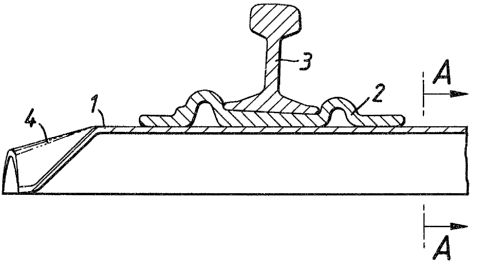Note: Descriptions are shown in the official language in which they were submitted.
~ltS5~
-- 1 --
This invention rela-tes to railway sleepers, and
more particularly relates -to channel-section rne-tal sleepers
having downwardly inclined 'spade~ ends.
Conventional spade end sleepers which have their
plain upper surfaces downwardly inclined at an angle of
between say 40 and up to 90 -to the horizontal suffer from
the drawback tha-t loads cannot readily be substained closely
adjacent these ends, because they 'dig in' to the ballast in
response to sideways movement, they cannot be readily
replaced for maintenance purposes etc. and with steep angled
ends they do not readily stack.
It is an object of this invention to provide an
improved sleeper which mitigates the above problems.
According to the invention there is provided a
railway sleeper having a formed inverted channel-shaped
section the ends of which have their upper surfaces
downwardly inclined and inwardly tapered over their central
region towards the sleeper extremities whereby to define at
these extremities a corrugated contour to add strength and
rigidity to the sleeper, these ends being press formed, the
sleeper being of consistent width and continuous form along
its entire length.
According to the invention there is further
provided a railway sleeper having a formed inverted channel-
shaped section the ends of which have their upper surfaces
downwardly inclined and inwardly tapered over their central
region towards the sleeper extremities so as to
progressively define at said extremities, in end elevation,
a serpentine path having downwardly inclined portins at the
side and two further such portions inwardly thereof, these
ends being press formed, the sleeper being of consistent
width and continuous form along its entire leng-th.
Preferably, the width across the bottom of the
inverted section is consistent along its whole leng-th
''
- la -
including the bottom of -the downwardly inclined side
portions at the ends, -the underside of the invert~d section
being flat over i-ts whole leng-th. Pre~erabl again, the
serpentine shape o~ each end is symmetrical, a U-shaped
depression lying centrally -thereo~.
The 'dished spade' end contour of the sleeper may
be pressed from a standard rolled steel channel section. By
virtue of the stron~er ends thus produced these portions can
sustain a greater
;
~`
load than the con~entional design hitherto - this means that the
length of the sleeper according to thi~ invention may be much
shorter, e.g. 2C% less than the conventional design for the æame
load bearing capacity, representing a conæiderable coæt æaving.
~he shape facilities stacking, and lateral insertion beneath
the track for track maintenance and replacement etc., and although
the end design i8 such that it affords less restraint against
lateral load thrustæ it is still 5~/0 or flO greater than the
standard concrete or wooden æleeper.
In order that the invention may be ~ully understood one embodiment
thereof will now be described with reference to the ac¢om-panying
drawings in which
Figure 1 is a longitudinal section on the centre line of a
æleeper according to the invention;
Figure 2 iS a plan view of the sleeper of ~igure 1 (without
the rail);
~igure 3 is a section on A-A in the above Figureæ; and
Figure 4 is an end elevation of Figure 2
Referring now to Figure 1 and 2 in the drawings a steel ~leeper 1
haæ~welded to it a rolled steel base plate 2 whi¢h in the example
shown has an inwardly sloping upper ~urfaoe suoh as to support a
r il 3 in a tilted fa~hion. lhe body of the sleeper is roll formed
and then the end is press formed in a manner suoh that the upper
surfaoe 4 is inolined downwardly and BO shaped as to progressively
define at itB extremity a ~erpentine or sinuous configuration.
~65~
", . ~,~
Thi~ i8 better illustrated in Figure 4 where it can be seen
that it approximates to an undulating path extending over 1~ cycles.
me sides each have upwardly inclined surfaces 5, 6 merging into
a ~-shaped central section havir~ downwardly inclined surfaces 7,8.
Four 'upright' portions are thus manifested by this form of
construction significantly strengthening the 31eeper ends giving
rise to the advantages claimed above.
To give practical example on the above, with a 1435mm track
gauge, the overall sleeper length may be 2,300mm, the a~-rolled
section (~ig.3) with side wall thickness of 6.75mm may have a
weight of 27 kg/metre with the total weight of the sleeper as
pressed in the normal indu6trial sleeper grade steel being 62 kg.
Although thé invention has been described with reference to
the particular embodiment illustrated, it is to be understood that
various modifications may readily be made without departing from
the soope of this invention. For example, the precise ~hape and
size of the ~trengthened 'corrugated' ends may differ from that
shown compatible with the objects as recited above.
.
